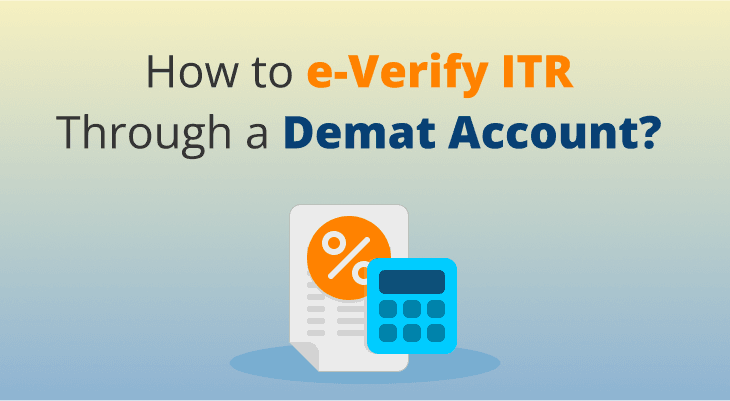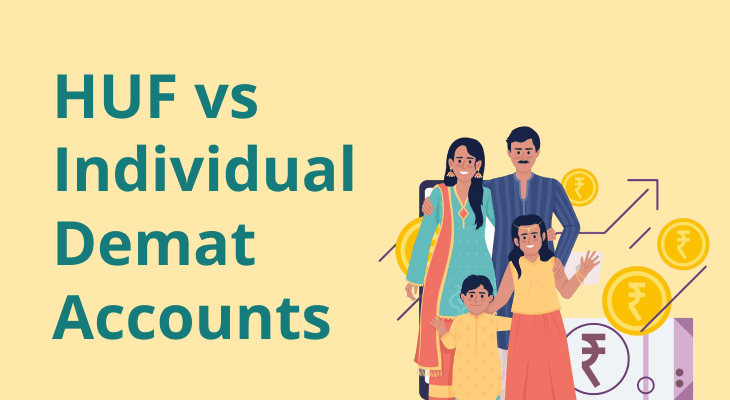
How to e-Verify ITR Through a Demat Account?
India has a wide and diverse economy with citizens of various income levels and professions. Naturally, every eligible citizen must fulfil their obligation of contributing to the nation's advancement by meeting their tax responsibilities. The government has set up distinct tax categories to ensure fair and proportional taxation. Understanding and adhering to these tax obligations is not solely a civic duty but also crucial for the progress of the country. Embarking on this civic responsibility entails the accurate and timely submission of income tax returns. Nevertheless, the submission of these returns represents just one facet; ensuring their appropriate handling by tax authorities holds equal significance.
The Evolution of Tax Return Authentication in India
In the historical records of Indian tax practices, the authentication of tax returns was once a laborious process marked by delays and complexities. Taxpayers had to manually send their ITR-V (Income Tax Return Verification form) via postal services. This approach was not only time-consuming but also vulnerable to inaccuracies and postal service setbacks. Such a system presented considerable obstacles, particularly in a nation as extensive and varied as India. Nevertheless, the advent of digital technology has ushered in a profound metamorphosis. The Income Tax Department has introduced electronic methods for verification, simplifying the process, boosting efficiency, and enhancing user-friendliness.
Comprehensive Exploration of Electronic Verification Options
In today's digital era, the Income Tax Department provides numerous electronic verification methods, each tailored to accommodate diverse taxpayer preferences:
Demat Account
This method links your financial securities with your tax records, creating a seamless connection between investments and tax compliance.
Aadhaar Card
India's unique biometric ID system offers a secure and reliable means to verify tax returns, leveraging cutting-edge biometric technology.
Net Banking
Employ your bank's online services to verify your returns, simplifying the process for individuals who are already accustomed to online banking.
Bank Account
The option to link your bank account for verification purposes provides an additional layer of convenience and flexibility.
ATM Card
While less common, using your bank's ATM services as a verification method remains a viable option for some taxpayers.
Each of these methods boasts its set of procedures and benefits, offering taxpayers flexibility and convenience.
How to e-Verify ITR Through a Demat Account?
E-verifying through a Demat Account represents an efficient method that harmonises financial securities with tax compliance. Below, we delve into an intricate breakdown of each step within this process:
User Registration
Initiate the process by visiting the Income Tax Department's e-filing portal.
Click on the 'Register Yourself' button to commence your registration.
Select your user type (Individual, HUF, etc.).
Furnish your basic details, including PAN, name, and date of birth.
Complete the registration form by providing your contact details and setting up a secure password.
Following successful registration, an activation link is dispatched to your email. Click on the link to activate your account.
Navigating To 'View Returns/Forms'
Log in to your account using your PAN and password.
Navigate to the 'Dashboard' and click on the 'View Returns/Forms' option to access your previously filed returns.
Reviewing Return Details
Within the 'View Returns/Forms' section, you will find a comprehensive list of your filed returns.
Select the specific return you wish to e-verify by clicking on the corresponding acknowledgement number.
Opting For Demat Account Verification
Once you have chosen the return, you will encounter an option for 'e-Verify.'
Select it, and among the various methods displayed, choose 'EVC using Demat Account.'
Prevalidating Your Demat Account
First-time users must validate their Demat account details.
Input essential information such as your Depository Type (NSDL or CDSL), Demat Account number, and Depository Participant ID.
Ensure that your mobile number and email ID linked with the Demat Account are current, as the EVC will be transmitted to these details.
Generating The EVC
Following successful prevalidation, you will receive an option to generate an Electronic Verification Code (EVC).
Upon requesting it, the EVC is dispatched to your registered mobile number and email.
Submitting The EVC
Input the 10-digit EVC in the designated space on the portal.
It's worth noting that this EVC remains valid for 72 hours from the time of generation.
Acknowledgment
Upon successful submission of the EVC, you will receive a confirmation message on your screen.
Additionally, a confirmation email will be sent to your registered email address.
The Advantages of E-Verification
E-verification of income tax returns offers a plethora of advantages, making it the preferred choice for taxpayers:
Convenience And Time-Saving
E-verification is an entirely online process, obviating the need for visits to tax offices or postal submissions.
It can be completed from anywhere, saving valuable time for taxpayers.
Instant Processing
The digital process enables immediate confirmation of return submission.
Swift verification leads to expedited processing of returns and subsequent refunds.
High Security And Privacy
Online verification boasts enhanced security features that safeguard sensitive financial information.
The utilisation of EVCs ensures that only the taxpayer can access and verify their return.
Cost Efficiency
It eliminates expenses related to printing, postage, and travel.
Furthermore, it is free of charge for users, constituting a cost-effective option.
Round-The-Clock Accessibility
Available 24/7, the system grants taxpayers the flexibility to verify their returns at their convenience.
Accuracy And Error Minimisation
It mitigates the likelihood of errors prevalent in manual processing.
Digital records guarantee accuracy and facilitate easy tracking of return status.
Environmental Sustainability
Promoting a paperless process aligns with environmental conservation efforts.
It contributes to reducing the carbon footprint associated with physical mailing.
Conclusion
The recent transformation in India's tax verification process represents a significant step towards better governance and increased convenience for taxpayers. The adoption of electronic verification techniques, especially via Demat Accounts, reflects a move towards a more transparent, secure, and user-friendly tax system. This change not only aids individual taxpayers but also enhances the overall effectiveness of the country's tax administration.
FAQ
What are the prerequisites for using a digitalised account for online authentication?
To employ your Digitised Account for e-authentication, you need to complete a preliminary validation on the Income Tax e-filing platform. This involves connecting your Digitised Account to your PAN, and ensuring your contact information, especially your mobile number and email address, is up to date. It's vital to highlight that the Digitalised Account should be registered in your name. This condition is of utmost importance as the Electronic Verification Code (EVC) for validating your tax return is sent to the registered contact details, ensuring a secure and personalised verification process.
What steps should I take if I don't receive the EVC on my mobile device?
If you fail to receive the EVC on your mobile device, the first step should be to verify the accuracy of your mobile number in both your Digitised Account and the e-filing portal. If the number is correct and you still haven't received the EVC, you can regenerate it through the e-filing portal. This process is simple: log in to your account, select the return you want to e-verify and request EVC generation again. If issues persist, consider contacting your Digitised service provider or seeking assistance from the IT Department's helpline.
Is it permissible to use someone else's digitised account for e-authentication?
No, using another person's Digitised Account to electronically verify your income tax returns is not permitted. Your Digitised Account must be registered in your name and linked to your PAN (Permanent Account Number). This rule is in place to ensure security and discourage unauthorised activities. The information in your tax records must align with the data in your Digitised Account. Any discrepancies could lead to complications during the verification process.
How can I determine the electronic verification status of my tax return?
To determine the electronic verification status of your tax return, access the Income Tax e-filing portal. Upon logging in, navigate to the 'Dashboard' and select 'View Returns/Forms.' At this juncture, a comprehensive roster of your tax return submissions will be available. Adjacent to each return, a status indicator will be displayed, conveying whether it has undergone electronic verification or if further steps are needed. This functionality serves to keep you informed about your tax filing status and any requisite follow-up measures.


